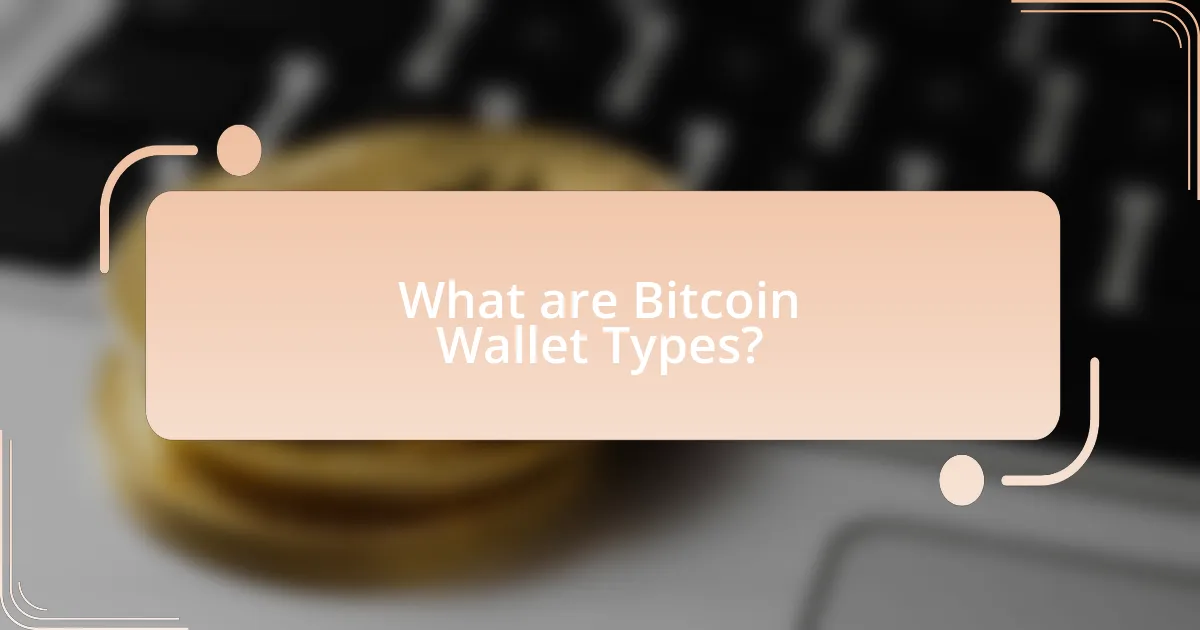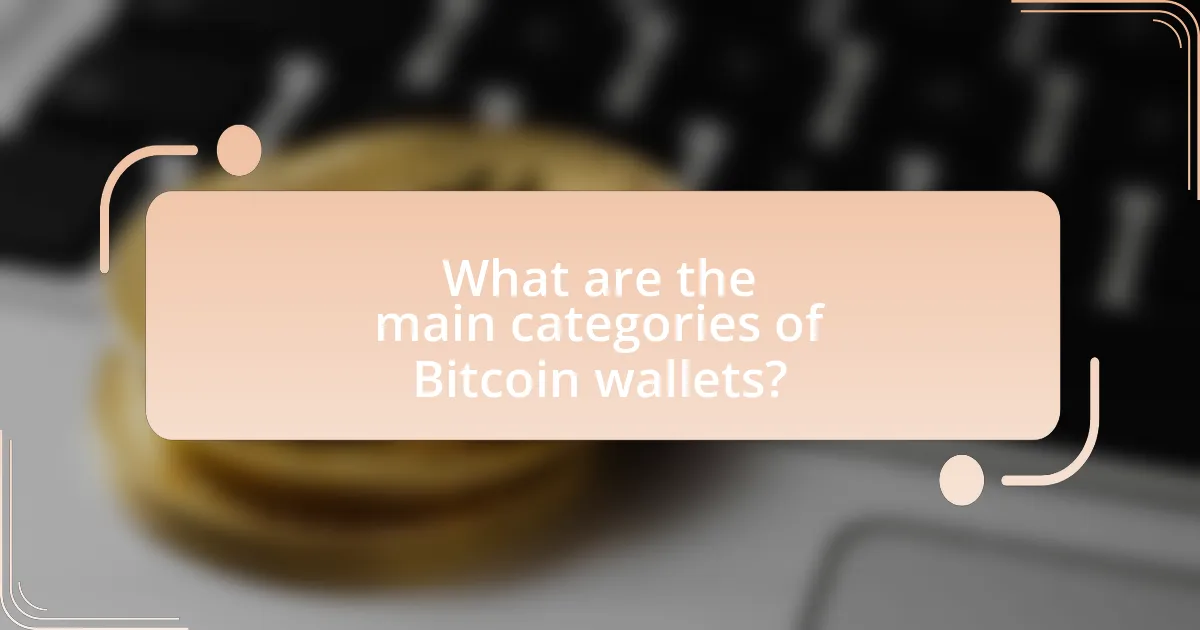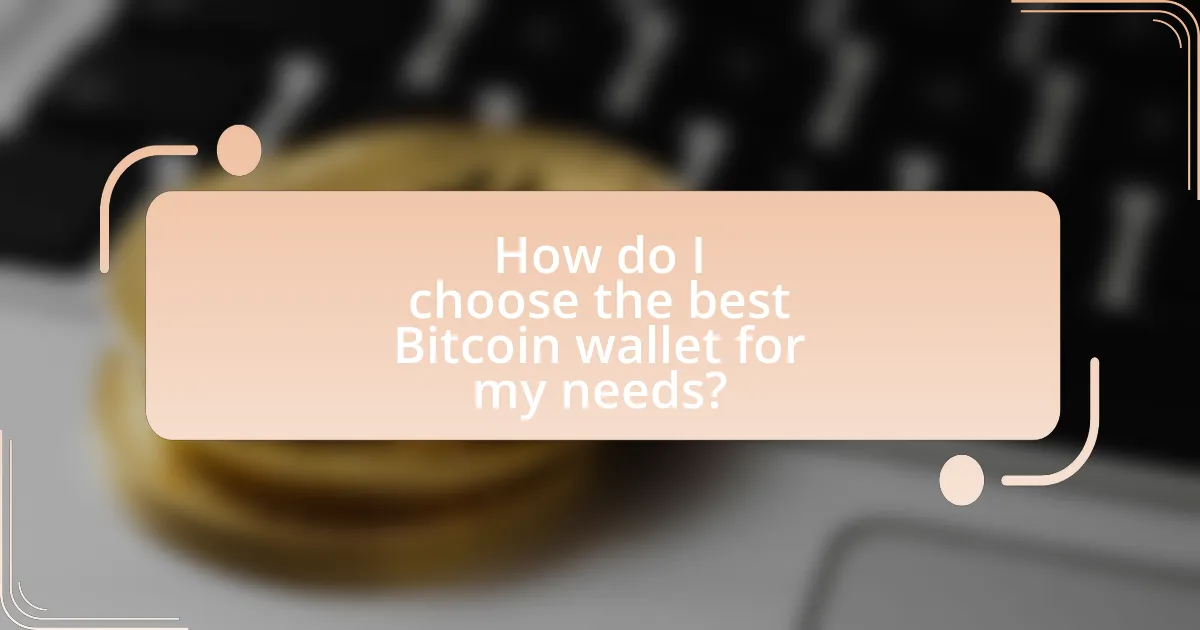The article provides a comprehensive overview of Bitcoin wallet types, including hardware, software, mobile, web, and paper wallets, each serving different user needs in terms of security, convenience, and accessibility. It explains how Bitcoin wallets function by securely storing private and public keys, facilitating transactions through cryptographic algorithms and the blockchain. The article emphasizes the importance of selecting the right wallet to mitigate risks associated with theft and loss, while also detailing the distinctions between hot and cold wallets, their security implications, and best practices for managing them effectively. Additionally, it highlights common mistakes to avoid and offers tips for ensuring wallet security and optimizing user experience.

What are Bitcoin Wallet Types?
Bitcoin wallet types include hardware wallets, software wallets, mobile wallets, web wallets, and paper wallets. Hardware wallets are physical devices that securely store private keys offline, making them highly secure against online threats. Software wallets are applications installed on computers or smartphones, offering a balance of convenience and security. Mobile wallets are specifically designed for smartphones, allowing users to make transactions on the go. Web wallets are cloud-based services that provide easy access to Bitcoin but may be more vulnerable to hacking. Paper wallets involve printing out the private keys and public addresses, providing a completely offline storage method. Each type serves different user needs, balancing security, convenience, and accessibility.
How do Bitcoin wallets function?
Bitcoin wallets function by securely storing the private and public keys necessary to send and receive Bitcoin. The private key allows the owner to access and manage their Bitcoin, while the public key serves as an address for others to send Bitcoin to. When a transaction occurs, the wallet uses the private key to sign the transaction, which is then broadcast to the Bitcoin network for verification and inclusion in the blockchain. This process ensures that only the owner can authorize transactions from their wallet, maintaining security and ownership of the Bitcoin.
What are the key components of a Bitcoin wallet?
The key components of a Bitcoin wallet include a private key, a public key, and a wallet address. The private key is a secure code that allows the owner to access and manage their Bitcoin, while the public key is derived from the private key and is used to generate the wallet address. The wallet address is a hashed version of the public key, which is shared with others to receive Bitcoin. These components work together to ensure secure transactions and ownership verification in the Bitcoin network.
How do these components interact to secure Bitcoin?
The components that interact to secure Bitcoin include cryptographic algorithms, the blockchain, and decentralized consensus mechanisms. Cryptographic algorithms, such as SHA-256, ensure that transactions are securely hashed, making it nearly impossible to alter transaction data without detection. The blockchain serves as a public ledger that records all transactions, providing transparency and immutability, which are essential for trust in the network. Decentralized consensus mechanisms, like Proof of Work, require miners to solve complex mathematical problems to validate transactions, thereby preventing double-spending and ensuring that only legitimate transactions are added to the blockchain. Together, these components create a robust security framework that protects Bitcoin from fraud and unauthorized access.
Why is it important to choose the right Bitcoin wallet?
Choosing the right Bitcoin wallet is crucial for ensuring the security and accessibility of your cryptocurrency. A suitable wallet protects your private keys, which are essential for accessing and managing your Bitcoin, thereby reducing the risk of theft or loss. For instance, hardware wallets, known for their high security, store keys offline, making them less vulnerable to hacking compared to software wallets that are connected to the internet. Additionally, the right wallet can enhance user experience by offering features such as ease of use, transaction speed, and compatibility with various platforms. According to a report by Chainalysis, 69% of stolen Bitcoin in 2020 was taken from online wallets, highlighting the importance of selecting a secure option to safeguard your assets.
What risks are associated with using the wrong wallet type?
Using the wrong wallet type can lead to significant risks, including loss of funds, security vulnerabilities, and compatibility issues. For instance, a hot wallet, which is connected to the internet, may expose users to hacking attempts, while a cold wallet, which is offline, may be less convenient for frequent transactions but offers enhanced security. Additionally, using a wallet that does not support specific cryptocurrencies can result in the inability to access or recover those assets, leading to permanent loss. According to a report by Chainalysis, over $3.8 billion in cryptocurrency was stolen in 2020, much of which was attributed to inadequate wallet security measures.
How can the right wallet enhance user experience?
The right wallet can enhance user experience by providing security, ease of use, and accessibility for managing Bitcoin transactions. A secure wallet protects users’ funds from theft and hacking, which is crucial given that over $1.9 billion in cryptocurrency was stolen in 2021 alone. Additionally, user-friendly interfaces simplify the process of sending and receiving Bitcoin, making it more approachable for beginners. Wallets that offer features like transaction history, balance tracking, and integration with exchanges further improve accessibility, allowing users to manage their assets efficiently.

What are the main categories of Bitcoin wallets?
The main categories of Bitcoin wallets are hot wallets, cold wallets, and hardware wallets. Hot wallets are connected to the internet and allow for quick access and transactions, making them convenient for everyday use. Cold wallets, on the other hand, are offline and provide enhanced security, ideal for long-term storage of Bitcoin. Hardware wallets are a type of cold wallet that store private keys on a physical device, offering a secure way to manage Bitcoin while still allowing for occasional online access. Each category serves different user needs based on the balance between convenience and security.
What are the differences between hot and cold wallets?
Hot wallets are online cryptocurrency wallets that are connected to the internet, while cold wallets are offline storage solutions that are not connected to the internet. Hot wallets, such as web wallets and mobile wallets, provide quick access to funds and facilitate easy transactions, making them convenient for everyday use. However, their constant internet connection makes them more vulnerable to hacking and cyber attacks. In contrast, cold wallets, including hardware wallets and paper wallets, offer enhanced security by keeping private keys offline, significantly reducing the risk of unauthorized access. This distinction is crucial for users to understand, as it impacts the safety and accessibility of their cryptocurrency holdings.
How does a hot wallet operate?
A hot wallet operates by storing cryptocurrency online, allowing for quick access and transactions. It connects to the internet, enabling users to send and receive digital assets easily. Hot wallets typically include software applications or web-based platforms that facilitate real-time trading and transfers. Due to their online nature, they are more vulnerable to hacking and cyber threats compared to cold wallets, which are offline storage solutions. This vulnerability is evidenced by numerous incidents where exchanges and hot wallet providers have experienced security breaches, leading to significant financial losses for users.
What are the security implications of using a hot wallet?
Using a hot wallet exposes users to significant security risks, primarily due to its constant internet connectivity. This connectivity makes hot wallets vulnerable to hacking, phishing attacks, and malware, which can lead to unauthorized access and theft of funds. For instance, in 2020, the Twitter hack demonstrated how social engineering could compromise accounts linked to hot wallets, resulting in the loss of over $100,000 in cryptocurrency. Additionally, hot wallets often lack the robust security features found in cold wallets, such as offline storage, making them less secure for long-term asset storage.
What are the various types of hot wallets?
Hot wallets are digital wallets that are connected to the internet, allowing for quick access to cryptocurrencies. The various types of hot wallets include web wallets, mobile wallets, and desktop wallets. Web wallets operate through a browser and are accessible from any device with internet access, while mobile wallets are applications installed on smartphones, providing convenience for on-the-go transactions. Desktop wallets are software applications downloaded and installed on personal computers, offering more control over private keys compared to web wallets. Each type of hot wallet facilitates easy transactions but comes with varying levels of security risks due to their online connectivity.
What is a web wallet and how does it work?
A web wallet is an online service that allows users to store, send, and receive cryptocurrencies through a web browser. Web wallets operate by storing the user’s private keys on a server managed by a third party, enabling easy access from any device with internet connectivity. This convenience comes with trade-offs, as users must trust the service provider to secure their funds, which can be vulnerable to hacking and other security risks. According to a report by the Cybersecurity & Infrastructure Security Agency, web wallets are often targeted due to their centralized nature, highlighting the importance of choosing reputable providers.
What are mobile wallets and their advantages?
Mobile wallets are digital applications that allow users to store, send, and receive cryptocurrencies and traditional currencies using their smartphones. The advantages of mobile wallets include convenience, as they enable quick transactions and easy access to funds on-the-go; enhanced security features, such as biometric authentication and encryption; and the ability to manage multiple currencies within a single app. According to a report by Statista, the global mobile wallet market is projected to reach over $7 trillion in transaction value by 2025, highlighting their growing adoption and utility in everyday financial activities.
What are the different types of cold wallets?
The different types of cold wallets include hardware wallets, paper wallets, and offline software wallets. Hardware wallets, such as Trezor and Ledger, store private keys on a physical device, providing enhanced security against online threats. Paper wallets involve printing the private and public keys on paper, which can be stored securely but are vulnerable to physical damage or loss. Offline software wallets are applications installed on a computer that is never connected to the internet, ensuring that private keys remain secure from online attacks. Each type of cold wallet offers distinct advantages in terms of security and usability, making them suitable for different user needs.
What is a hardware wallet and how does it function?
A hardware wallet is a physical device designed to securely store cryptocurrency private keys offline. It functions by generating and storing these keys in a secure environment, protecting them from online threats such as hacking or malware. When a user wants to make a transaction, the hardware wallet signs the transaction internally without exposing the private keys to the internet, ensuring that the keys remain safe. This method of operation significantly reduces the risk of theft, as the keys are never transmitted over potentially insecure networks.
What are paper wallets and their benefits?
Paper wallets are physical documents that contain a user’s private and public keys for cryptocurrency transactions, typically printed in QR code format. The primary benefit of paper wallets is enhanced security, as they are offline and immune to hacking, malware, or online theft. Additionally, paper wallets allow for easy storage and transfer of cryptocurrencies without the need for digital devices, making them a cost-effective option for long-term storage. According to a study by the University of Cambridge, offline storage methods like paper wallets significantly reduce the risk of unauthorized access compared to online wallets.

How do I choose the best Bitcoin wallet for my needs?
To choose the best Bitcoin wallet for your needs, assess your priorities such as security, convenience, and accessibility. Security features like two-factor authentication and private key control are crucial for protecting your assets. Wallet types include hardware wallets, which offer high security for long-term storage, and software wallets, which provide ease of use for daily transactions. According to a 2021 survey by Statista, 46% of cryptocurrency users prefer mobile wallets for their convenience, while 29% opt for hardware wallets for enhanced security. Evaluating these factors will help you select a wallet that aligns with your specific requirements.
What factors should I consider when selecting a wallet?
When selecting a wallet, consider security, usability, compatibility, and backup options. Security is paramount; choose wallets with strong encryption and two-factor authentication to protect your assets. Usability refers to how easy the wallet is to navigate; a user-friendly interface enhances the experience, especially for beginners. Compatibility with various cryptocurrencies is essential, as some wallets support only specific coins, limiting your options. Lastly, ensure the wallet has reliable backup options to recover funds in case of device loss or failure, as losing access to a wallet can result in permanent loss of assets.
How does security influence wallet choice?
Security significantly influences wallet choice by determining the level of protection users have over their digital assets. Users prioritize wallets that offer robust security features, such as two-factor authentication, encryption, and private key control, to mitigate risks of theft and hacking. For instance, hardware wallets, which store private keys offline, are often preferred for their enhanced security compared to software wallets that are connected to the internet. According to a study by the Cambridge Centre for Alternative Finance, 40% of cryptocurrency users cite security as their primary concern when selecting a wallet, highlighting its critical role in decision-making.
What role does user experience play in wallet selection?
User experience is crucial in wallet selection as it directly influences user satisfaction and the ease of managing cryptocurrency. A positive user experience ensures that users can navigate the wallet interface intuitively, perform transactions efficiently, and access features without confusion. Research indicates that 70% of users abandon a wallet due to poor usability, highlighting the importance of a seamless experience in retaining users. Additionally, wallets that prioritize user experience often incorporate features like customer support, educational resources, and security measures, which further enhance user confidence and engagement.
What are some common mistakes to avoid when using Bitcoin wallets?
Common mistakes to avoid when using Bitcoin wallets include not securing private keys, using weak passwords, and failing to back up wallet data. Securing private keys is crucial because losing them means losing access to funds permanently. Weak passwords can be easily compromised, leading to unauthorized access. Additionally, not backing up wallet data can result in irreversible loss of funds if the device is lost or damaged. According to a study by Chainalysis, approximately 20% of Bitcoin in circulation is lost due to these types of mistakes, highlighting the importance of proper wallet management.
How can I ensure my wallet is secure?
To ensure your wallet is secure, use strong passwords and enable two-factor authentication. Strong passwords should be at least 12 characters long, combining letters, numbers, and symbols, which significantly reduces the risk of unauthorized access. Two-factor authentication adds an additional layer of security by requiring a second form of verification, such as a text message or authentication app, making it harder for attackers to gain access even if they have your password. According to a study by the Cybersecurity & Infrastructure Security Agency, implementing these security measures can reduce the likelihood of a successful cyber attack by up to 99%.
What should I do if I lose access to my wallet?
If you lose access to your wallet, you should first attempt to recover it using any backup phrases or recovery keys you may have saved. Wallets often provide a recovery seed phrase during setup, which can restore access to your funds if you have lost your device or password. If you do not have a backup, recovery may not be possible, as most wallets do not have a centralized recovery option. This is a critical aspect of cryptocurrency security, as the decentralized nature of blockchain technology means that users are responsible for their own access and security.
What are the best practices for managing Bitcoin wallets?
The best practices for managing Bitcoin wallets include using hardware wallets for enhanced security, enabling two-factor authentication, regularly updating wallet software, and keeping backup copies of wallet recovery phrases in secure locations. Hardware wallets, such as Ledger or Trezor, store private keys offline, significantly reducing the risk of hacks. Two-factor authentication adds an extra layer of security by requiring a second form of verification for transactions. Regular software updates ensure that the wallet is protected against vulnerabilities. Additionally, securely backing up recovery phrases prevents loss of access to funds in case of device failure or loss. These practices are essential for safeguarding Bitcoin assets against theft and loss.
How can I keep my wallet information safe?
To keep your wallet information safe, use strong, unique passwords and enable two-factor authentication. Strong passwords should be at least 12 characters long, combining letters, numbers, and symbols, which significantly reduces the risk of unauthorized access. Two-factor authentication adds an extra layer of security by requiring a second form of verification, such as a text message or authentication app, making it harder for attackers to gain access even if they have your password. According to a study by the Cybersecurity & Infrastructure Security Agency, enabling two-factor authentication can block up to 99.9% of automated attacks.
What tips can help me effectively use my Bitcoin wallet?
To effectively use your Bitcoin wallet, ensure you choose a reputable wallet provider that prioritizes security features such as two-factor authentication and encryption. A study by the Cambridge Centre for Alternative Finance indicates that security is a primary concern for Bitcoin users, with 40% of users reporting security issues. Regularly update your wallet software to protect against vulnerabilities, and back up your wallet data securely to prevent loss. Additionally, familiarize yourself with transaction fees and network conditions to optimize your transactions. Following these tips will enhance your experience and security while using a Bitcoin wallet.